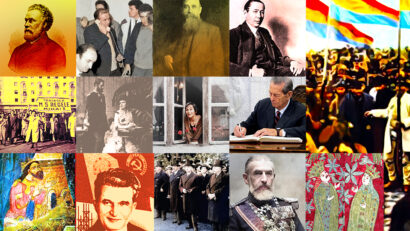Iosif Berman and Early Romanian Photojournalism
One of the first Romanian photojournalists was Iosif Berman, considered a groundbreaking artist in photography.

Steliu Lambru, 18.01.2016, 13:20
Before photography, newspapers were illustrated with drawings. Photography was a major shift in the press, granting it added credibility. A new profession was born, that of photojournalist, which elevated this job to the level of art. The history of 20th century press is studded with legendary photos, a combination of daily life, visual art, symbolic content, gestures and sentiment.
One of the first Romanian photojournalists was Iosif Berman, considered a groundbreaking artist in photography. He was born in 1892 in Dorohoi, in a Jewish merchant family. His father fought for Romania’s independence in the 1877 war. At that time, Jews could not obtain Romanian citizenship. Iosif Berman turned photography into a lifelong passion. According to his daughter, it seems that this passion was sparked while he was visiting Chernowitz. In 1912, Berman went to Bucharest to pursue his passion, winning his first award for photography, which earned him his first job. His biographer, journalist Adina Stefan, is the editor of the photo album called ‘Iosif Berman’s Romania’. She recounts the early career of the most important Romanian inter-war photographer.
“His colleagues were saying he had the makings of an American photojournalist, and that he was even better. In 1912 he went to Bucharest to take part in a competition to get a job in the press, which he won, and started working at the illustrated Gazette. Later, he worked for Constantin Mille, for the newspapers Adevarul and Dimineata, where he spent about two decades. He came to publish his photos in the illustrated Reality magazine, contributed art photos to Cuvantul Liber, alongside great artists of that time, some of them avant-garde. Berman became a star, and he never compromised on quality. And that in spite of the fact that there was no glamour involved, he was simply a very visible and charismatic person. He left behind tens of thousands of photos.”
By definition, a journalist has to be curious, to uphold the truth and be a people person, and Berman was custom cut for this. The war was a great occasion for journalists to shine, and WWI was Berman’s moment to prove to himself that he was an artist, and a daring one since he went straight to the front line. During that time, he also met his future wife:
“Since he was such a dynamic man, in 1917 Berman was attached to a regiment that was going to Russia, having the opportunity to photograph the front line. He documented the fighting in the war and the Bolshevik Revolution. He lived an adventure there that could have cost him his life, and he lost his photos. He met both the Whites and the Reds, he was nabbed by both sides, and both of them smashed his photo plates. He wondered the shores of the Black Sea, from Odessa to the foot of the Caucasus, at Novorossisk. A scene worth of a movie comes next, with him exhausted in a café where some young people were talking. He was offered some food and drink, one of the young people offered to take him home and give him a place to rest. Berman accepted, and the following day, when he had recovered a bit, he found himself in a well-to-do household, a Jewish home. On a balcony he saw a pretty girl combing her hair. It was love at first sight. Her name was Raisa, she was 20 years old, and he was 27. The decision to marry came swiftly.”
Until 1923, Berman lived in Constantinople together with his wife, working as a corresponding photojournalist of the dailies Dimineata and Adevarul. The increasing number of sports lovers made Berman a successful photographer also for the sports publications. Barman’s career also had an academic side to it. He had a close cooperation with sociologist Dimitrie Gusti in his interviewing campaigns in Romania’s rural areas. The emergence of the ethnographic photography genre is largely due to Berman. His reputation reached the great press institutions bringing him collaborations with the paper New York Times and the Associated Press and Scandinavian Newspapers Press agencies. He soon became the photographer of King Carol II. Here is Adina Ştefan with details:
“Berman became a competitive photojournalist who brought new things to photographic art, in the sense that he photographed everything. He never missed anything. He took photos of life scenes, his characters are alive, expressive and adequate. His daughter Luiza said that, at a certain moment, her dad had become the official photographer of King Carol II. He managed to take photos of the King in any circumstance and each and every time the king was captured on film in a royal posture. And this was Berman’s great talent, that made him unique among professional photographers.”
The prospect of WWII, the racial legislation in 1938 Romania and the anti-Semite persecutions were successive blows to Berman who could no longer follow his passion. He had to change his name which sounded Jewish. The dailies which he worked for were closed down and he had his camera and photos confiscated. Until 1940 he could work only sporadically, after which he was forbidden to work at all. On September 17, 1941, in the grips of depression and of a kidney disease, Iosif Berman died in Bucharest at the age of 49.





























